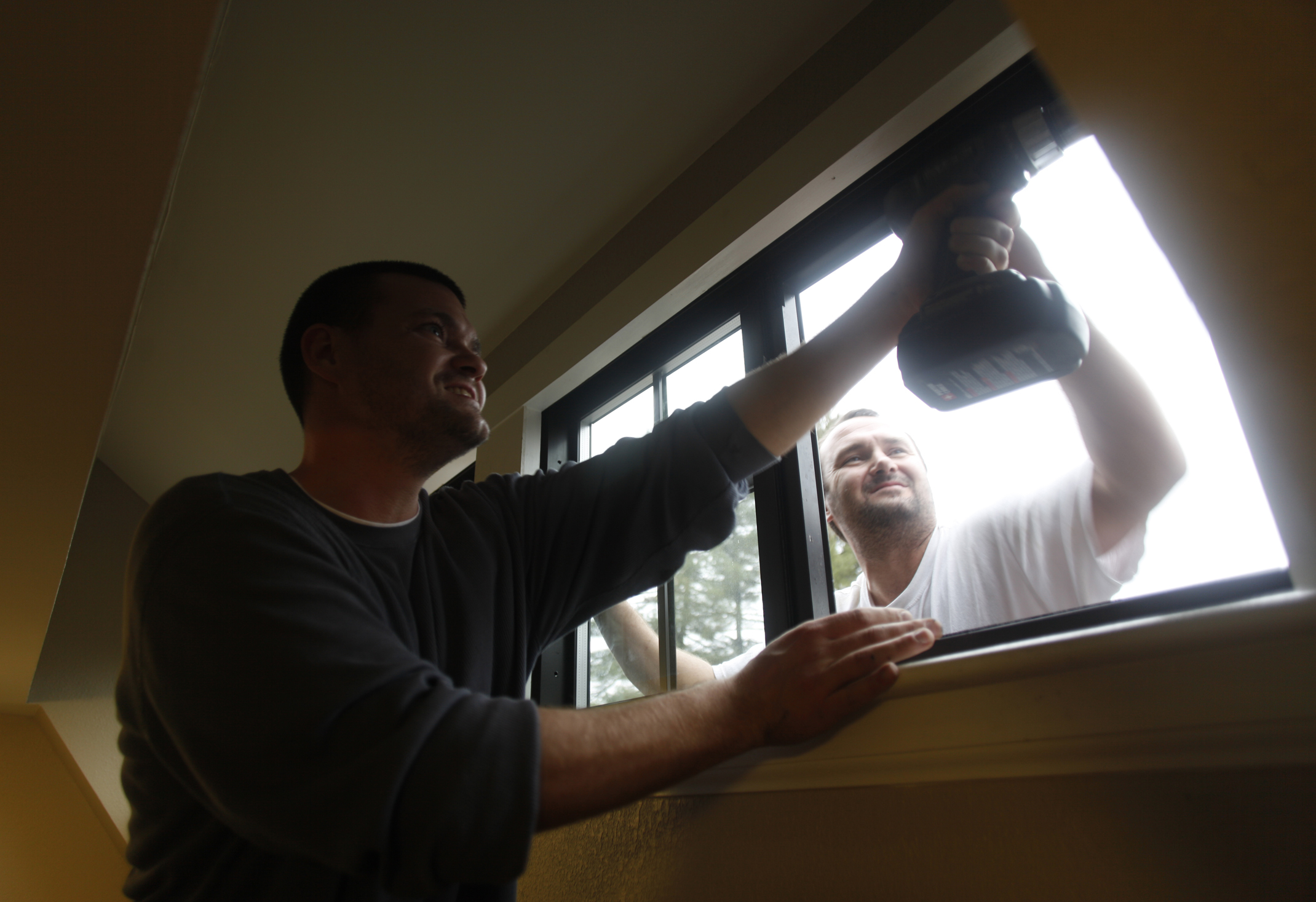 Chad Neese secures a window with screws while his brother Zach, rear, holds the window in place as the pair finish up renovations to Cannon Hall on Thursday afternoon. Cannon Hall, a dormitory on the Sewanee campus near Monteagle, Tenn., has been renovated to expand its capacity and update the facility to the university's green and sustainable initiative, including drinking fountains with bottle refill stations and recycling stations.
Chad Neese secures a window with screws while his brother Zach, rear, holds the window in place as the pair finish up renovations to Cannon Hall on Thursday afternoon. Cannon Hall, a dormitory on the Sewanee campus near Monteagle, Tenn., has been renovated to expand its capacity and update the facility to the university's green and sustainable initiative, including drinking fountains with bottle refill stations and recycling stations.Sustainable campus practices at UTC and Sewanee• Replacing incandescent light bulbs with lower wattage bulbs• Placing recycling bins in dormitories• Replacing older cooling and heating systems with more efficient practices• Bike share program (UTC)• Repurposing building materials from old buildings into new buildings (Sewanee)Source: Sewanee: The University of the South and the University of Tennessee at Chattanooga
After 90 years, Cannon Hall will finally have air conditioning.
Last summer, Sewanee: The University of the South gutted the dormitory to provide more housing for its growing student body, and also to align the old building with a new goal -- sustainability.
The dorm, which was built in the 1920s, is the first building to use what the school calls "Sewanee Standards," a series of building codes based in part on LEED standards, but tailored and improved upon by the university.
The renovation is the first test of the standards, using local materials and incorporating many green features, including air conditioning that will be attached to the school's new efficient central cooling system, a recycling center and water bottle stations where students can refill water bottles.
"The sustainability initiative takes a very holistic approach from the standpoint that it's not just one building, its multiple buildings," said Reggie Vachon, assistant director of physical plant services. "It's sustainability in practice, not just in theory."
In recent years, as environmental awareness has grown nationwide, sustainability has become a major focus for university campuses.
Recycling bins have become as common as garbage cans. Energy efficient lighting and calculations of a school's carbon footprint have become hallmarks on many campuses.
Paying for savings
Though a greener university will save money in the long run, the startup costs can be staggering. At Sewanee, the new cooling system, which should be installed this summer, cost $1.1 million. But it will be 60 percent more efficient.
"Though more buildings will be using [the cooling system], we're not anticipating a significant [increase] in the utilities," Vachon said. "We expect little to no change, and even possibly lower costs."
At the University of Tennessee at Chattanooga, the new Lupton Library, which will be LEED certified, cost $48 million.
Already the university has saved about $2.5 million through upgrading its energy and water use, according Linda Collins, associate professor in the department of biological and environmental sciences and a member of the environmental task force.
Many universities, including Sewanee and UTC, have added full-time staff members to coordinate and push environmental goals forward. At Sewanee, a sustainability master plan is in the works.
"People have believed in sustainability and been working it piecemeal, but efforts have not been coordinated until recently," said Lisa Darger, UTC's sustainability coordinator.
UTC students petitioned the university to embrace more green practices, including a sustainability coordinator. They even voted to add a fee to pay for the green upgrades.
What used to be simple paper recycling now includes plastics and aluminum. More efficient light bulbs replace incandescent bulbs. UTC's master plan commits to a goal of carbon neutrality, or no carbon emissions, by 2030.
A new, efficient geothermal heating and cooling system is in the works.
Building awareness
But these efforts are not without some pains.
For every step forward UTC takes, Darger said, there's a new opportunity for education.
"Reducing electricity, changing lighting -- these are things we can control," she said. "A lot of it is behavioral change and changing people's mindset. You automatically look at a recycling bin when you have a plastic bottle; you turn the lights off when you leave a room."
UTC's next big project will be a focus on transportation, another part of its carbon neutrality goal.
The university's engineering department also recently received a grant to be a zero-energy building, or a building that creates more energy than it uses.
Sewanee -- in its not-so-urban setting atop the Cumberland Plateau -- plans to work on its carbon neutrality by protecting its surrounding forest and continuing to implement energy conservation practices.
"With this place being on top of a mountain, sustainability has been in our DNA since the beginning," said Jon Evans, assistant provost for environmental stewardship and sustainability. "It's really been this past year that we have really taken the commitment to a whole new level."
There are plans to integrate sustainability into every part of the university from job descriptions, which currently are being rewritten, to classrooms.
"We use our own campus as a model and important training ground for students," Evans said.
"No one campus is going to save the world," he continued. "What we're doing here is training students who will go out there and hopefully save it."
